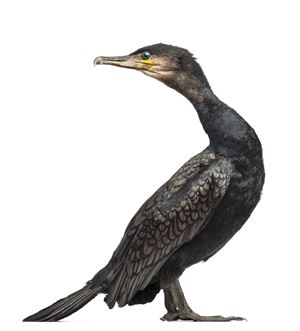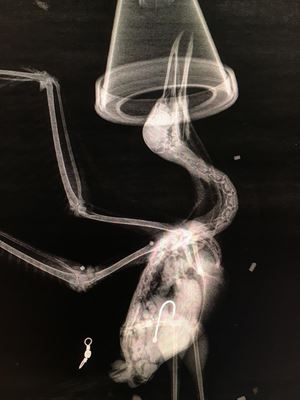Help us untangle this environmental mess.
Wednesday, February 21, 2018
While Sydney was preparing for another spectacular fireworks display, ‘Gal’ the Great Cormorant was fighting for her life.
On New Year’s Eve WIRES rescuer Michaela and her husband found themselves abandoning their plans and jumping into a creek at a reserve in South West Sydney.
Michaela remembers seeing “a large bird that seemed to be drowning about five metres away from the shore. It was a Great Cormorant, completely exhausted and probably only minutes from death”.
Gal was entangled in metres of fishing line which was cutting into her left shoulder as it wrapped around her body multiple times. Michaela’s husband said that there were four different lines around her, two of which were attached to a float. He also found five fishing hooks attached to her body.
He was able to cut some line and get her to shore. The usually majestic and strong bird was coughing up water and was very weak.
“One of the fishing hooks had pierced through her beak and leg at the same time so she was not only in pain but she could barely move,” recalls Michaela.
Michaela and her husband travelled through Sydney, on what has to be the busiest night of the year, to reach an emergency vet.
Gal received antibiotics and stitches for two wounds on her left wing. One of the wounds was two centimetres wide, caused from the fishing line which had embedded into her skin.
The hooks were carefully removed from Gal’s body. The vet identified them as Treble hooks, which feature three barbs per hook. It is not uncommon for Seabirds to receive multiple wounds from these hooks, which dramatically decreases their chance of survival.
The strong-willed Cormorant recovered quickly and was successfully released back to the wild in the first week of January.
By supporting WIRES you will help us rescue more animals like Gal this year.
“When we left, there was still lots of fishing line in the water, including a float. Who knows how many hooks were under the water?” said Michaela, feeling frustrated at the cause of Gal’s injuries.
Later that week Michaela returned to the creek in an effort to clean up the area and prevent further animals suffering the same fate as Gal.

Discarded recreational items such as fishing line, string and plastics are creating multiple hazards for Australian wildlife. Fishing line, like the one around Gal, does not biodegrade. It readily wraps around the feet, legs, wings and even necks of animals, especially the ones who inhabit coastal areas. These types of entanglements can cause swelling and deep wounds. Animals including seabirds, raptors and turtles can have these materials constricting or embedded into their skin for weeks or months before being sighted and reported.
Abandoned fishing hooks are also known to puncture vital organs if swallowed and plastic items are often mistaken as food and then ingested causing serious internal injuries.
The x-ray image is of a young seagull found on Sydney’s Bronte Beach. It was unable to fly and when WIRES rescuers arrived they believed it to have a broken wing caused by fishing line which had become wrapped around the bird’s body. A radiograph later confirmed it had swallowed a hook with a weight attached. The seagull couldn’t be saved.
WIRES’ teams are active all over NSW helping animals in similar situations. We can report that there were 1,382 entangled animals reported to WIRES in 2017. This is more than 3 animals every day.
In the biodiversity conservation act 2016, Entanglement in or ingestion of anthropogenic debris in marine and estuarine environments is listed as a key threatening process for wildlife. The NSW government has recognised in legislation that man-made waste is resulting in population decline and the threat of extinction for some of our native animals.
Items which are tossed away, never to be thought of again, have huge consequences and our wildlife is paying the price. No species is immune to discarded waste which is causing pain and suffering to thousands of animals every year.
As marine debris and plastic pollution increases, so does the impact on wildlife. Help by sharing our infographic-Get Hooked on helping wildlife.
In 2015, National Geographic stated that plastic can be found in over 90% of Seabirds and research suggests that the number continues to climb.
WIRES rescuers are doing all they can to alleviate the pain and suffering caused by this situation but we need help. A gift today can allow us to invest more resources into rescuing and rehabilitating our native animals.

Recent Posts
WIRES launches its first wildlife rehabilitation centre - Mullyang
WIRES Emergency Response in the wake of ex-tropical cyclone Alfred
International Women’s Day Volunteer Spotlight: Shelley
Tropical Cyclone Alfred – Emergency Wildlife Advice
Interview with WIRES Training and Development
Celebrating Women in Science: The Journey of Holly, Wildlife Conservationist and WIRES Team Member
